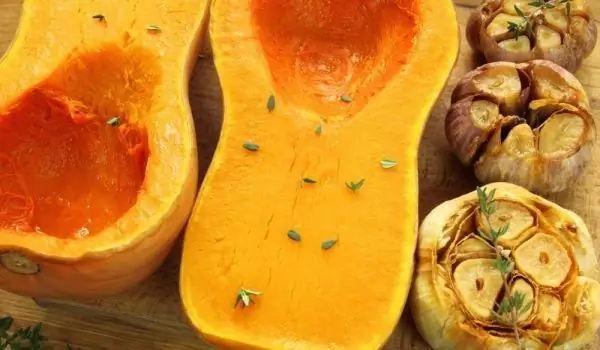2025 Author: Jasmine Walkman | [email protected]. Last modified: 2025-01-23 10:18
Pumpkin is a plant belonging to the so-called. fruit vegetables. A favorite dessert of young and old, it is extremely useful and healthy.
When you decide to grow pumpkins, you must first choose the right place for the purpose. The pumpkin grows in well-lit and sheltered from the sun places. The selected soil should be rich in nutrients, well fertilized by the previous crop.
Tillage is done in the fall. It starts with disking, which destroys the weeds, after which deep plowing is done - at 30-35 cm. Manure, phosphorus and potassium fertilizers are imported through it.

In the spring the soil is cultivated again, creating a good heat and air-gas regime in the soil. For this purpose it is cultivated 1-2 times at a depth of 12-14 cm without turning the soil layer, importing 25-30 kg of ammonium nitrate per decare.
Sowing of pumpkins is carried out at the end of April, when the temperature at a depth of 10 cm in the soil reaches 14 ° C. The possibility of frost should also be taken into account, and the possibility of them affecting plants when they have already sprouted should be avoided.
Nests are made with the help of a hoe measuring 40-50 cm. 5-6 seeds are sown in each of them. They are placed on floors, ie. half are sown shallower than the others. For better and faster growth it is good to practice rotting the seeds.
Ruthenia is pre-soaking for 10-12 hours in lukewarm water (28-30 ° C). For one decare you will need about 300-500 seeds.

After digging, it is good to throw well-rotted manure on the nests, which will retain moisture and keep the surface always loose. After sowing the seeds, regular tillage is needed, such as digging and watering, as well as weed control.
The first hoeing of the pumpkins is done after the formation of the first true leaf, and the second is done before the plants have fully developed lateral branches. When the plants form 2-3 true leaves, they are transplanted and thinned, leaving 1 plant in a nest.
Even if you do not have time to water the pumpkins regularly, do not worry - they have a well-developed root system and excellent ability to use moisture from the lower soil layers.
The produce is harvested at the end of September, before the heavy autumn rains, after the leaves start to burn. The fruits are edible after being left in the sun for 20-25 days after being picked. This improves their quality and shelf life.
Recommended:
Types Of Pumpkins - Delicious And Terribly Useful

The pumpkin is a traditional product for the Bulgarian table. This is especially true in autumn and winter, when we like to eat it in the form of different types of desserts. Apart from being tasty and fragrant, pumpkin is also very useful.
Storage And Canning Of Pumpkins

Pumpkin adds fiber to your diet and is a rich source of vitamin A. Naturally, the low calorie content of pumpkin, which contains only traces of sodium and fat and is cholesterol-free, makes it an excellent choice for a healthy diet. Unfortunately, we can't say the same about pumpkin pie with whipped cream
Bulgaria Is The Largest Producer Of Pumpkins In The EU

On Halloween, for which many Bulgarians argue whether we should celebrate it or not, it turns out that Bulgaria is the largest producer of the symbol of this holiday - the pumpkin. According to Eurostat data for the territory of the European Union, Bulgaria is the largest producer of pumpkins.
Trivia About Pumpkins And Why Use Them More Often

Autumn is always the season for pumpkins, so be sure to stock up on them. We will not surprise anyone if we mention that they are extremely tasty and useful and in addition to eating their meat, we also use the seeds, both for health problems and just for fun.
Varieties Of Pumpkins And Their Features

For their long history, when new ones began to be created varieties of pumpkins , have been artificially produced quite a bit, and sometimes their variety can greatly confuse you. In general, we can divide pumpkins into several categories: - With hard bark (also known as ordinary);

